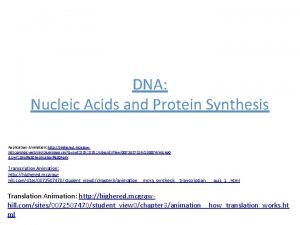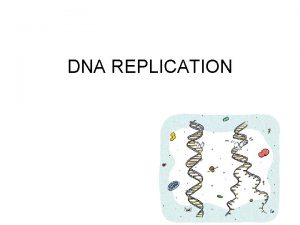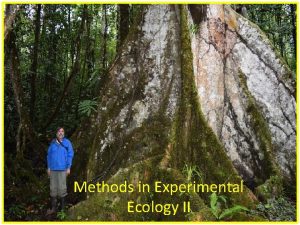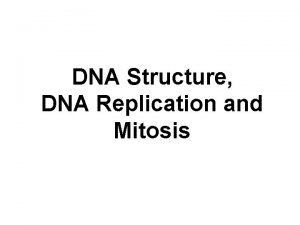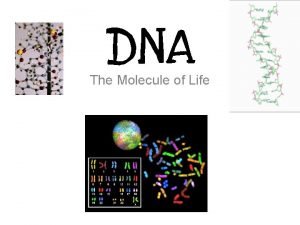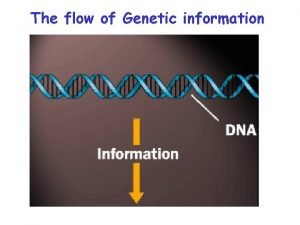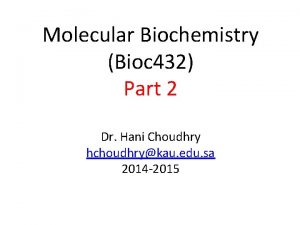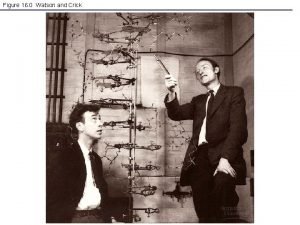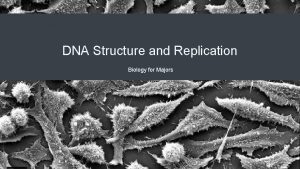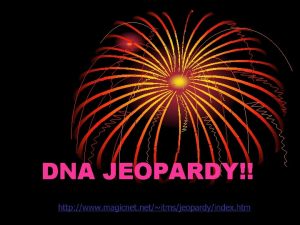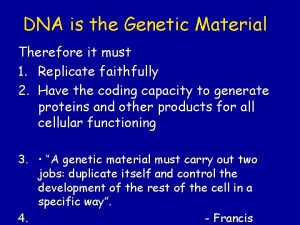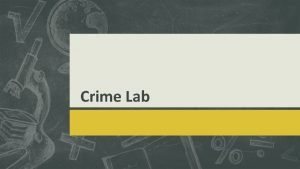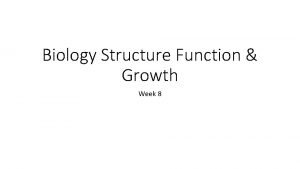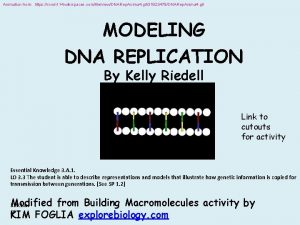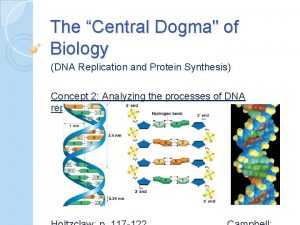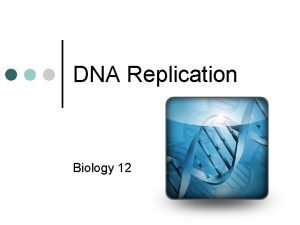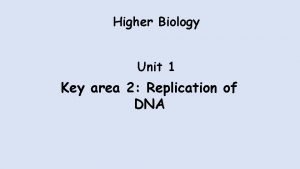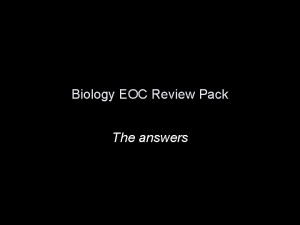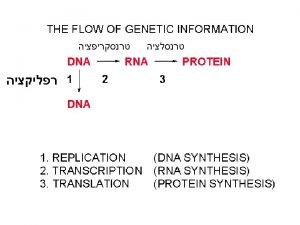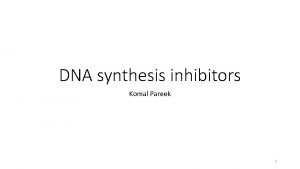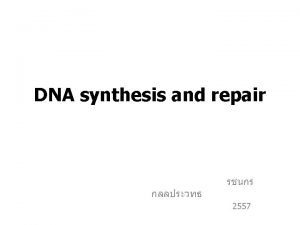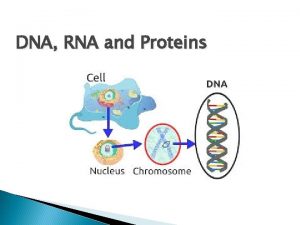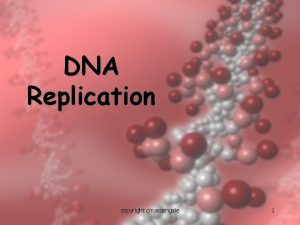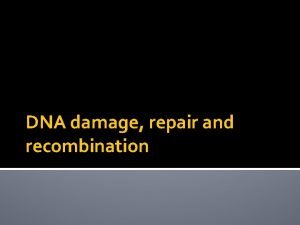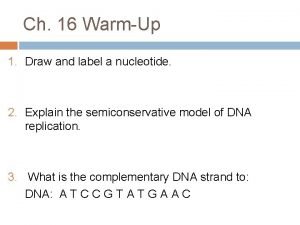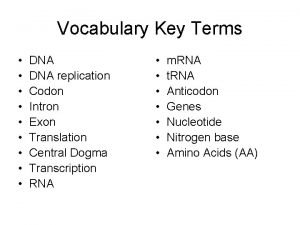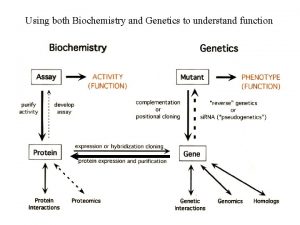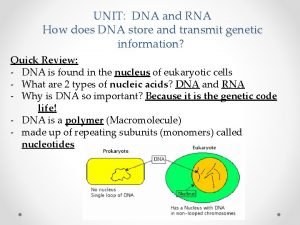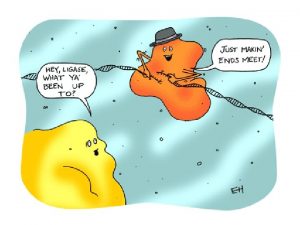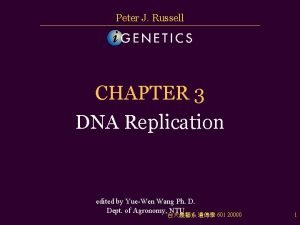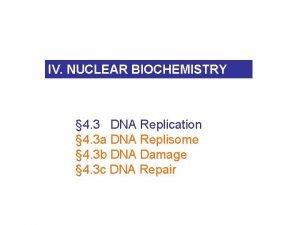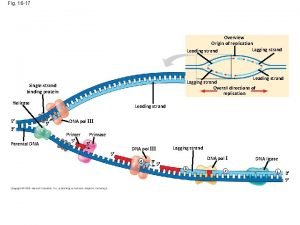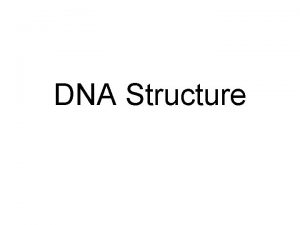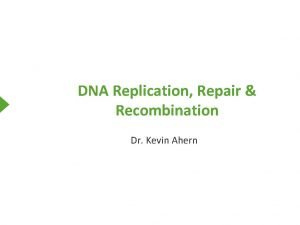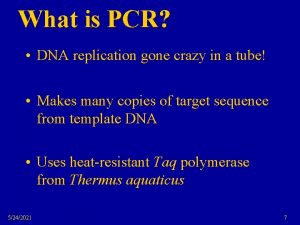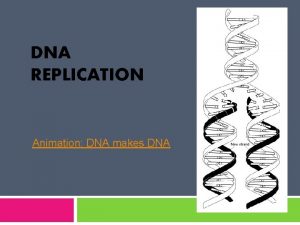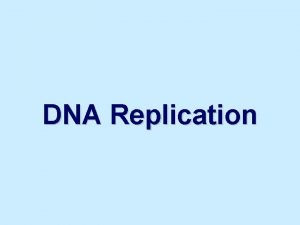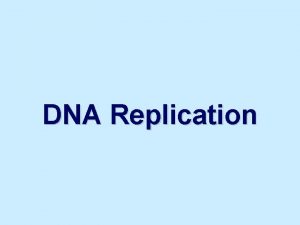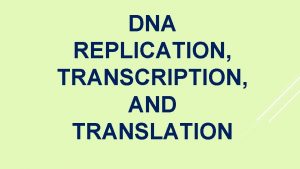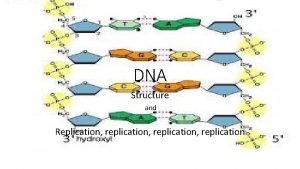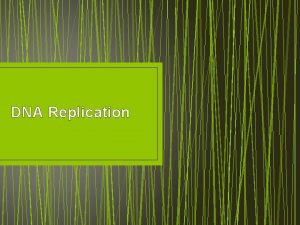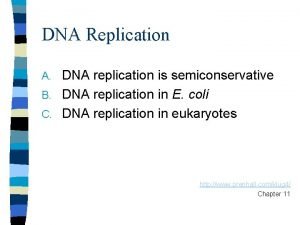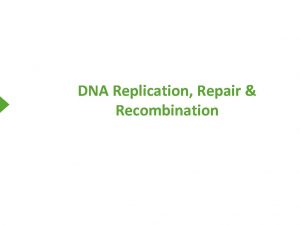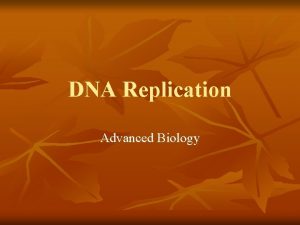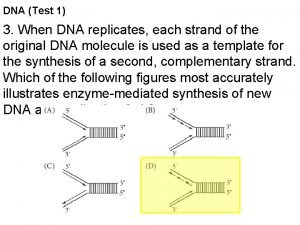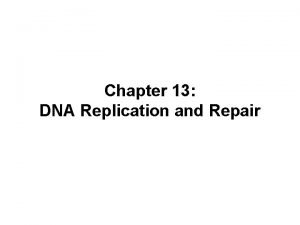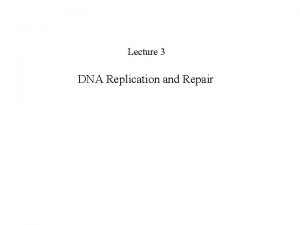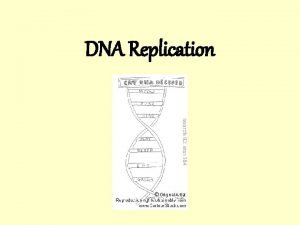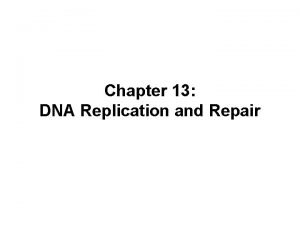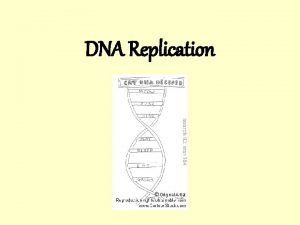DNA REPLICATION Animation gone Crazy DNA Replicates and

















































- Slides: 49

DNA REPLICATION

Animation gone Crazy • DNA Replicates and Replicates

DNA is anti-parallel • Two strands run parallel to each other but with opposite alignments (directions) • Mc. Graw-Hill DNA • Why is being antiparallel an advantage to the DNA molecule?

DNA REPLICATION • Semi-conservative = each one of the parent DNA strands is passed to the daugher DNA + one new strand for each • Semi-conservative DNA (30 secs) SNEAK PREVIEW: DNA REPLICATION PLAYERS (enzyme review)


Fill out DNA Replication Enzymes CHART • Lots of enzymes are needed to start each step


Topoisomerase • Topoisomerase Youtube I and II (1: 45) • Topoisomerase Animation (2: 16)

Enzyme Helicase: Helicase separates (breaking Hbonds) double helix at the replication fork DNA-RNA-Protein (see ani) YOU TUBE DNA replication (1: 05)

DNA Helicase • The enzyme is unwinding the chain and breaking the H-bonds between the complementary base pairs (A-T, G-C).


RNA Primer • Nucleotides for the starting point for DNA replication • Short strands of RNA


DNA replication is initiated at many points in eukaryotic chromosomes. • Called Replication Bubbles • They will eventually all meet to form whole replicated strand

DNA Replication Bubble: DNA duplicates in both directions




SSB’s single strand binding proteins • Stabilize the DNA strands as they are being replicated • Prevents rejoining of DNA strands

DNA Polymerases • DNA Polymerase I • Cuts off RNA primers and fills in with DNA (between Okazaki fragments) – lagging strand • Can proofread • DNA Polymerase III • Elongates the strand by adding DNA nucleotides on leading strand • Also proofreads and corrects the DNA strand

Anti-parallel strand builds in the opposite direction (but always in 5’ to 3’ direction)

Leading Strand Lagging Strand • Template strand of • Other DNA strand DNA • Forms short strands • Continuous addition of of Okazaki fragments nitrogenous bases (that will be joined later) • in 5’ to 3’ direction • Mc. Graw-Hill Replication Fork • in the 5’ to 3’ direction • DNA Replication You Tube (1: 35)

• OKAZAKI FRAGMENTS • The short strands of newly made DNA fragments on the lagging strand are called Okazaki fragments after the Japanese Biochemist Reiji Okazaki. •


DNA LIGASE is the enzyme that joins the Okazaki fragments (sugar phosphate backbone) with covalent bonds DNA REPLICATION (look for ligase) 2: 00

SUMMARY DNA Replication (5: 45) – shows all the enzymes • Summary Youtube of DNA replication (4: 11) • Good explanation of the 5’ to 3’ strands and leading and lagging strands

Includes all your friendly enzymes • DNA Replication (3: 56) Great animation

How Fast? • Prokaryotic DNA polymerase can work at about 1000 bases per second. • Eukaryotic DNA polymerase can work at about 50 bases per second.

Animation: DNA Replication • DNA makes DNA • *DNA with enzymes cartoons


• Mc. Graw Hill Replication Fork animation

DNA Replication Easy Version (3: 11) • DNA Replication Youtube (7: 48) • Good CLICK and REVIEW

What if there is a mistake?

DNA Replication Activity Work in Lab Groups • Card stock papers are original DNA strands • Colored paper are new DNA strands • MAKE OWN ENZYMESconstruction paper


Telomeres • At the ends of each chromosome is a protective cap called a telomere. • Each time a cell divides, the telomeres are snipped shorter,

Telomerase • enzyme which adds DNA sequence repeats ("TTAGGG" in all vertebrates) to the 3' end of DNA strands (an overhang) • Mc. Graw Hill Telomeres Animation

Telomeres Added to ends of chromosomes Rutgers Telomere Animation

QUIZ • Activity (choose your enzymes and proteins)

MOVIE • Media Showcase (cool animation) • Replication Overview Movie



QUESTION • In this diagram of the process of DNA replication at a replication fork, the strand labeled B is the: • A template strand • B lagging strand • C leading strand • D Okazaki fragment • E RNA primer

QUESTION • In this diagram of the process of DNA replication at a replication fork, the newly synthesized DNA strand labeled C is the: A coding strand • B parental DNA • C leading strand • D lagging strand

ANSWER • C lagging strand • The lagging strand is the newly synthesized DNA where addition of nucleotides is on the end opposite or away from the replication fork.

QUESTION • In this diagram of the process of DNA replication at a replication fork, the black boxes labeled D and E are: • A RNA primers • B DNA template strands • C Okazaki fragments • D DNA polymerase • E Newly synthesized DNA strand

ANSWER • A. RNA primers • The initiation of replication always starts with a short RNA piece. The DNA replicating enzymes will only add nucleotides to the 3' end of DNA.

QUESTION • For the DNA strand 5'-TACGATCATAT-3' the correct complementary DNA strand is: A 3'-TACGATCATAT-5 • 'B 3'-ATGCTAGTATA-5‘ • C 3'-AUGCUAGUAUA-5‘ • D 3'-GCATATACGCG-5‘ • E 3'-TATACTAGCAT-5'

ANSWER • B 3'-ATGCTAGTATA-5'
 Bioflix activity dna replication lagging strand synthesis
Bioflix activity dna replication lagging strand synthesis Dna sequence
Dna sequence Dna replication fork animation
Dna replication fork animation Pseudo replicates
Pseudo replicates Nonliving particle that replicates inside a living cell
Nonliving particle that replicates inside a living cell Replication
Replication Dna rna protein synthesis homework #2 dna replication
Dna rna protein synthesis homework #2 dna replication Dna structure and replication pogil
Dna structure and replication pogil Multiple choice questions on dna structure and replication
Multiple choice questions on dna structure and replication Dna replication transcription and translation
Dna replication transcription and translation Nature of dna replication
Nature of dna replication Traditional vs computer animation
Traditional vs computer animation Dna stand for
Dna stand for 3-5 exonuclease vs 5-3 exonuclease
3-5 exonuclease vs 5-3 exonuclease 5 enzymes responsible for dna replication
5 enzymes responsible for dna replication 3 models of dna replication
3 models of dna replication Major enzymes in dna replication
Major enzymes in dna replication Accgtat
Accgtat Dna jeopardy
Dna jeopardy Dna replication fork
Dna replication fork Dna replication vs pcr
Dna replication vs pcr What is this
What is this Nucleoside triphosphate in dna replication
Nucleoside triphosphate in dna replication Bioflix dna replication
Bioflix dna replication Protein synthesis restaurant analogy
Protein synthesis restaurant analogy Fork dna
Fork dna Higher biology dna replication
Higher biology dna replication Why is dna replication considered semiconservative
Why is dna replication considered semiconservative Dna replication pearson
Dna replication pearson Dna replication direction 5' 3'
Dna replication direction 5' 3' Dna replication in bacteria occurs
Dna replication in bacteria occurs Dna replication
Dna replication Dna polymerase proofreading
Dna polymerase proofreading Dna replication comic strip
Dna replication comic strip Dna replication facts
Dna replication facts Accuracy of dna replication
Accuracy of dna replication Bioflix dna replication
Bioflix dna replication Dna replication
Dna replication Dna synthesis at replication fork
Dna synthesis at replication fork Dna replication phschool
Dna replication phschool Bioflix dna replication
Bioflix dna replication Significance of replication
Significance of replication What are the enzymes involved in dna replication
What are the enzymes involved in dna replication Intercalating agents
Intercalating agents Dna replication fork
Dna replication fork Dna replication
Dna replication Dna replication
Dna replication Dna primase
Dna primase Replication fork
Replication fork Orc dna replication
Orc dna replication

